Exploring Price Elasticity: An Economics Course Assignment
VerifiedAdded on 2023/06/10
|11
|1703
|452
Homework Assignment
AI Summary
This economics assignment provides a detailed explanation of price elasticity of demand and supply, differentiating between own price elasticity and cross price elasticity. It elucidates the concepts of elastic and inelastic demand, illustrating how the quantity demanded changes in response to price variations. The assignment further explores the differences between the slope of the demand curve and the elasticity of demand, highlighting how elasticity varies along a demand curve with a constant slope. It emphasizes the role of substitutes in determining elasticity, explaining how the availability of substitutes influences the elasticity of demand for a product. Lastly, the assignment discusses the impact of price elasticity on a firm's revenue and pricing decisions, demonstrating how revenue changes with price increases under elastic and inelastic demand conditions. Desklib offers a wealth of similar solved assignments and past papers to aid students in their studies.
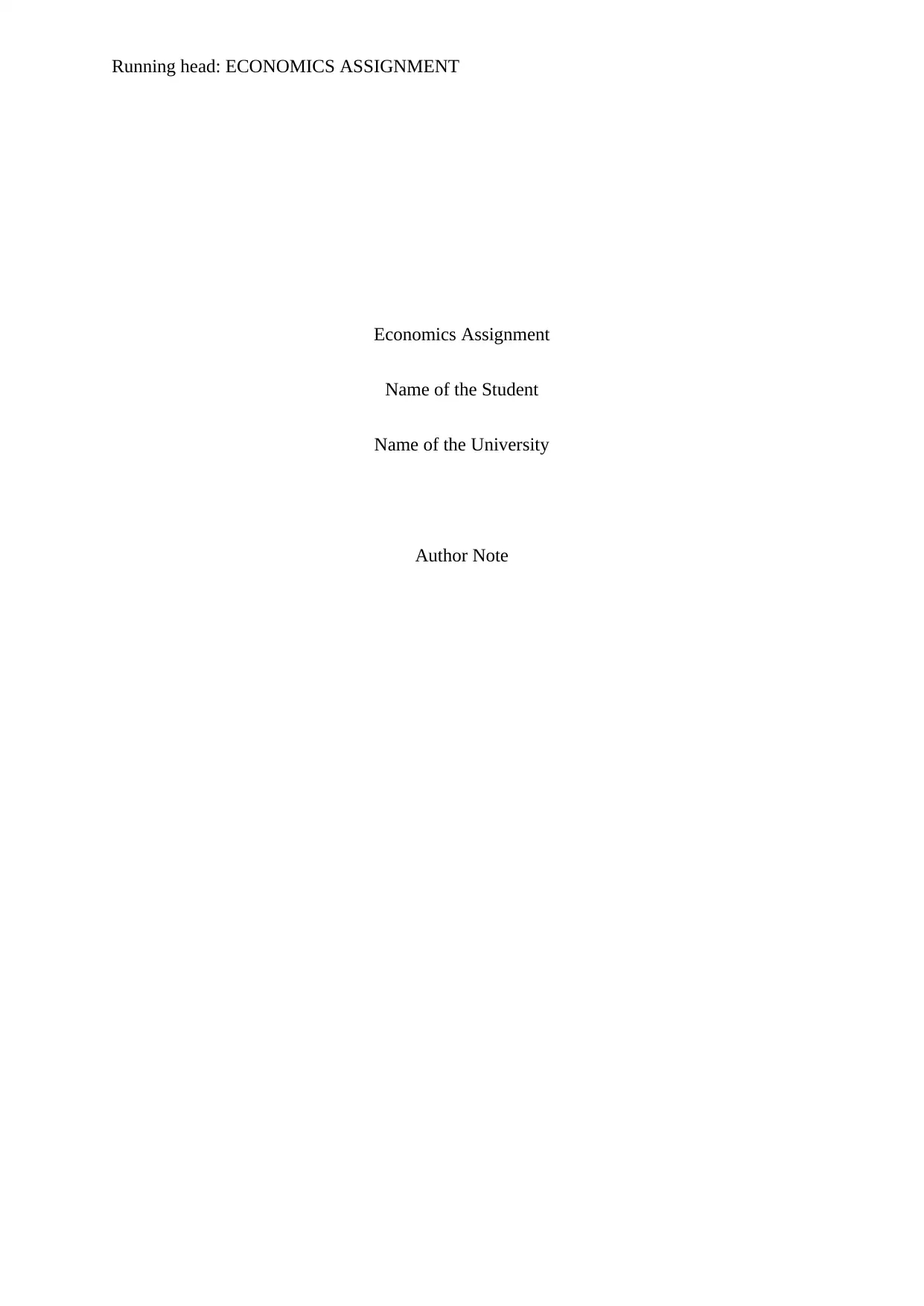
Running head: ECONOMICS ASSIGNMENT
Economics Assignment
Name of the Student
Name of the University
Author Note
Economics Assignment
Name of the Student
Name of the University
Author Note
Paraphrase This Document
Need a fresh take? Get an instant paraphrase of this document with our AI Paraphraser
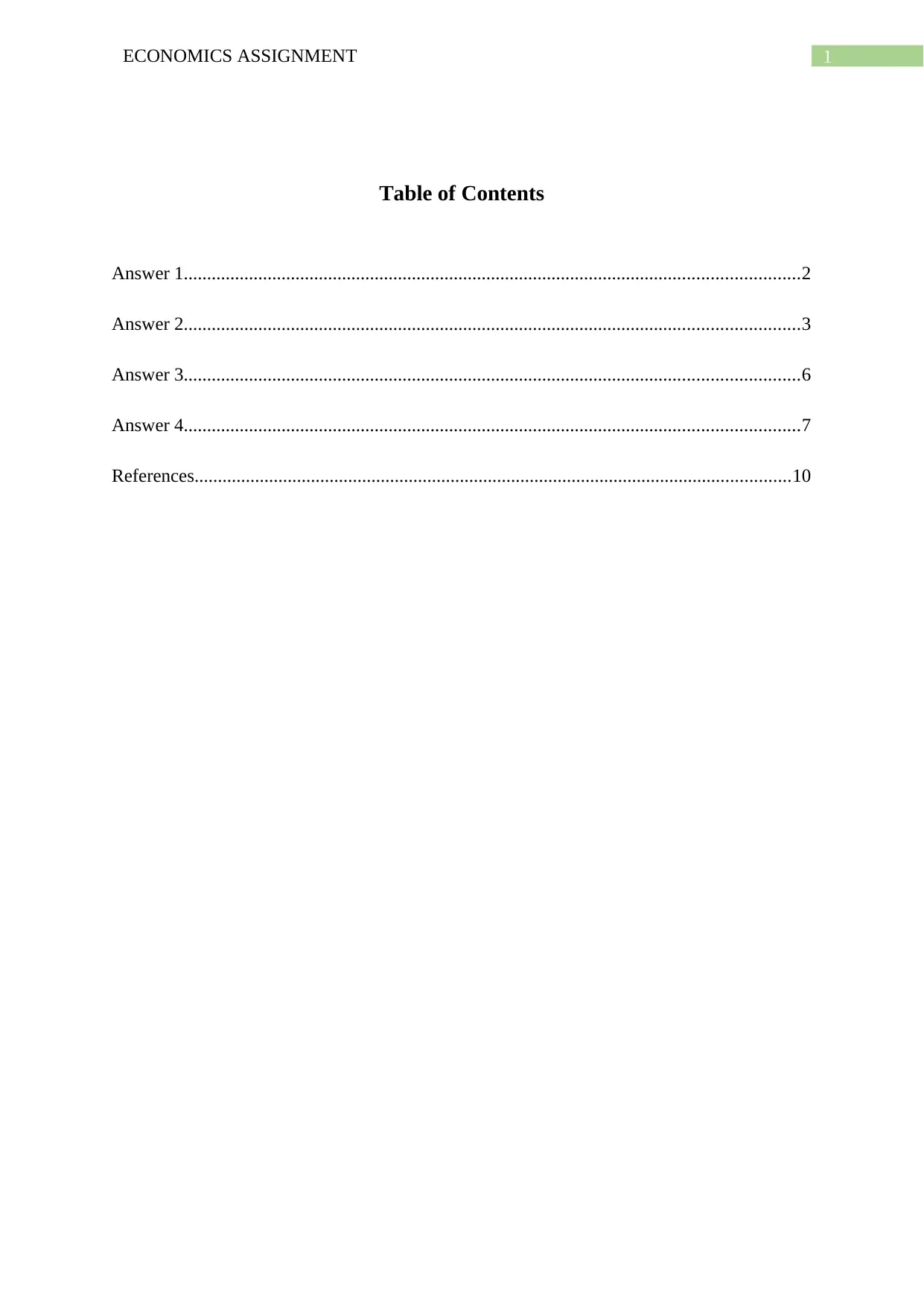
1ECONOMICS ASSIGNMENT
Table of Contents
Answer 1....................................................................................................................................2
Answer 2....................................................................................................................................3
Answer 3....................................................................................................................................6
Answer 4....................................................................................................................................7
References................................................................................................................................10
Table of Contents
Answer 1....................................................................................................................................2
Answer 2....................................................................................................................................3
Answer 3....................................................................................................................................6
Answer 4....................................................................................................................................7
References................................................................................................................................10
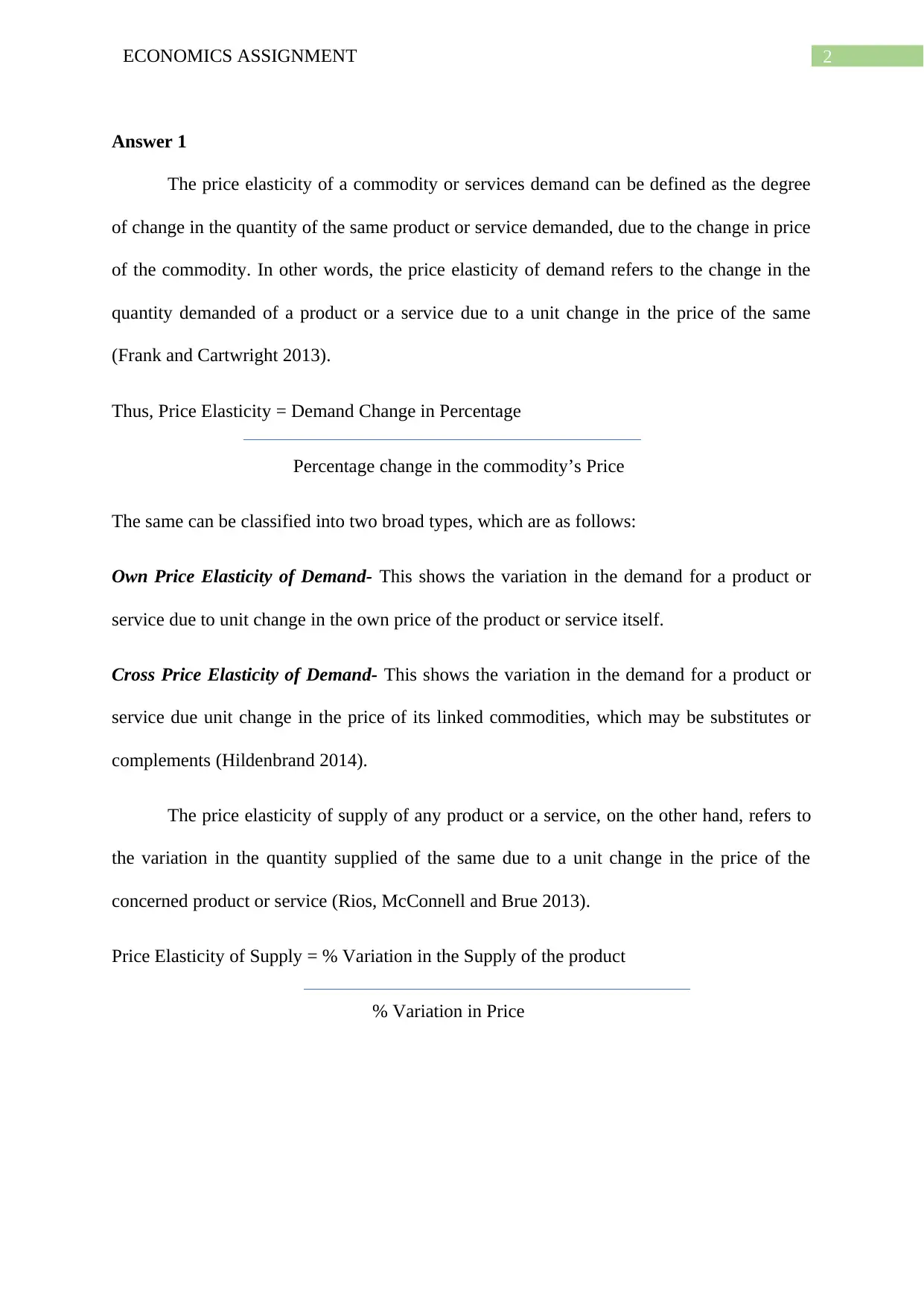
2ECONOMICS ASSIGNMENT
Answer 1
The price elasticity of a commodity or services demand can be defined as the degree
of change in the quantity of the same product or service demanded, due to the change in price
of the commodity. In other words, the price elasticity of demand refers to the change in the
quantity demanded of a product or a service due to a unit change in the price of the same
(Frank and Cartwright 2013).
Thus, Price Elasticity = Demand Change in Percentage
Percentage change in the commodity’s Price
The same can be classified into two broad types, which are as follows:
Own Price Elasticity of Demand- This shows the variation in the demand for a product or
service due to unit change in the own price of the product or service itself.
Cross Price Elasticity of Demand- This shows the variation in the demand for a product or
service due unit change in the price of its linked commodities, which may be substitutes or
complements (Hildenbrand 2014).
The price elasticity of supply of any product or a service, on the other hand, refers to
the variation in the quantity supplied of the same due to a unit change in the price of the
concerned product or service (Rios, McConnell and Brue 2013).
Price Elasticity of Supply = % Variation in the Supply of the product
% Variation in Price
Answer 1
The price elasticity of a commodity or services demand can be defined as the degree
of change in the quantity of the same product or service demanded, due to the change in price
of the commodity. In other words, the price elasticity of demand refers to the change in the
quantity demanded of a product or a service due to a unit change in the price of the same
(Frank and Cartwright 2013).
Thus, Price Elasticity = Demand Change in Percentage
Percentage change in the commodity’s Price
The same can be classified into two broad types, which are as follows:
Own Price Elasticity of Demand- This shows the variation in the demand for a product or
service due to unit change in the own price of the product or service itself.
Cross Price Elasticity of Demand- This shows the variation in the demand for a product or
service due unit change in the price of its linked commodities, which may be substitutes or
complements (Hildenbrand 2014).
The price elasticity of supply of any product or a service, on the other hand, refers to
the variation in the quantity supplied of the same due to a unit change in the price of the
concerned product or service (Rios, McConnell and Brue 2013).
Price Elasticity of Supply = % Variation in the Supply of the product
% Variation in Price
⊘ This is a preview!⊘
Do you want full access?
Subscribe today to unlock all pages.

Trusted by 1+ million students worldwide
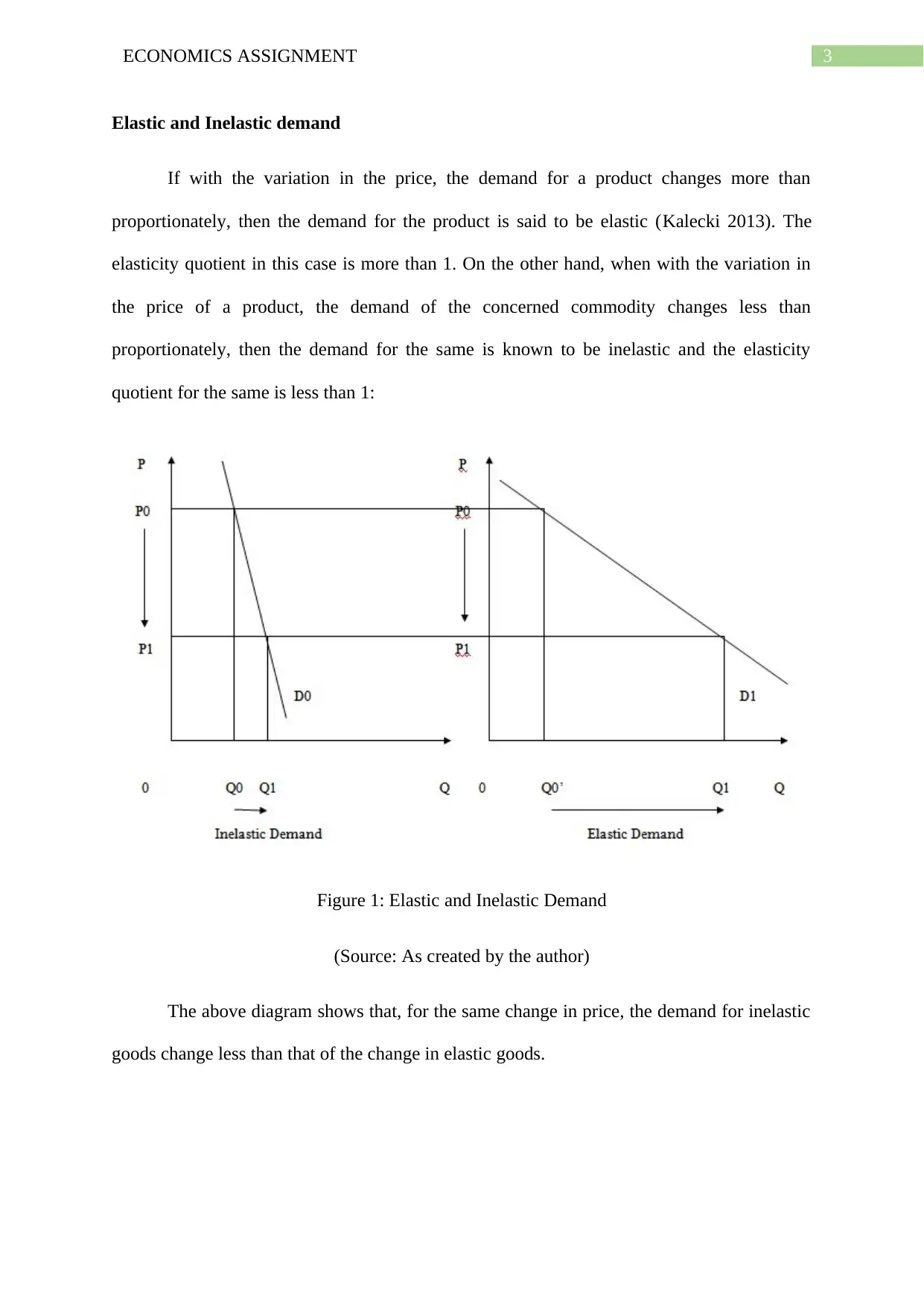
3ECONOMICS ASSIGNMENT
Elastic and Inelastic demand
If with the variation in the price, the demand for a product changes more than
proportionately, then the demand for the product is said to be elastic (Kalecki 2013). The
elasticity quotient in this case is more than 1. On the other hand, when with the variation in
the price of a product, the demand of the concerned commodity changes less than
proportionately, then the demand for the same is known to be inelastic and the elasticity
quotient for the same is less than 1:
Figure 1: Elastic and Inelastic Demand
(Source: As created by the author)
The above diagram shows that, for the same change in price, the demand for inelastic
goods change less than that of the change in elastic goods.
Elastic and Inelastic demand
If with the variation in the price, the demand for a product changes more than
proportionately, then the demand for the product is said to be elastic (Kalecki 2013). The
elasticity quotient in this case is more than 1. On the other hand, when with the variation in
the price of a product, the demand of the concerned commodity changes less than
proportionately, then the demand for the same is known to be inelastic and the elasticity
quotient for the same is less than 1:
Figure 1: Elastic and Inelastic Demand
(Source: As created by the author)
The above diagram shows that, for the same change in price, the demand for inelastic
goods change less than that of the change in elastic goods.
Paraphrase This Document
Need a fresh take? Get an instant paraphrase of this document with our AI Paraphraser
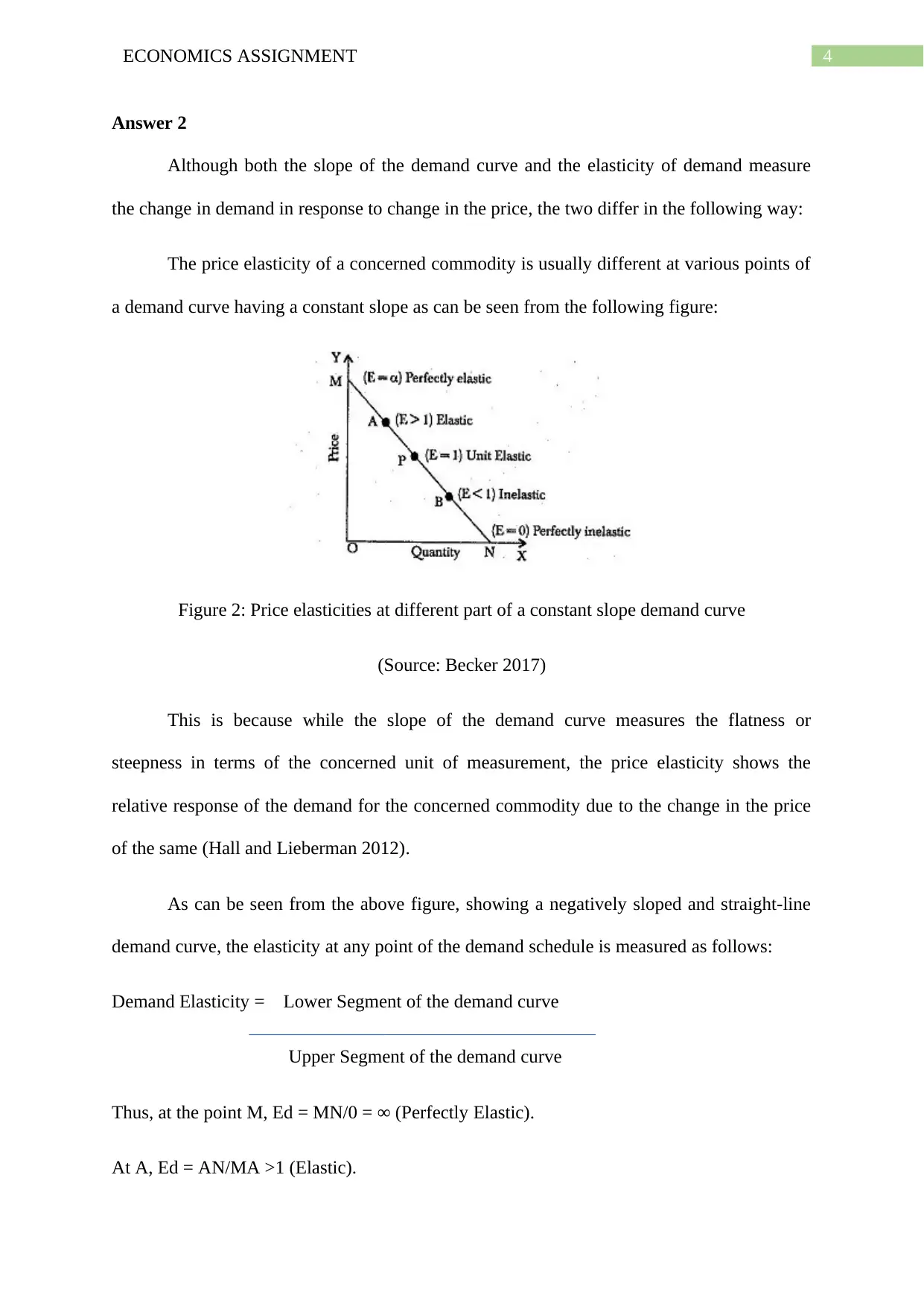
4ECONOMICS ASSIGNMENT
Answer 2
Although both the slope of the demand curve and the elasticity of demand measure
the change in demand in response to change in the price, the two differ in the following way:
The price elasticity of a concerned commodity is usually different at various points of
a demand curve having a constant slope as can be seen from the following figure:
Figure 2: Price elasticities at different part of a constant slope demand curve
(Source: Becker 2017)
This is because while the slope of the demand curve measures the flatness or
steepness in terms of the concerned unit of measurement, the price elasticity shows the
relative response of the demand for the concerned commodity due to the change in the price
of the same (Hall and Lieberman 2012).
As can be seen from the above figure, showing a negatively sloped and straight-line
demand curve, the elasticity at any point of the demand schedule is measured as follows:
Demand Elasticity = Lower Segment of the demand curve
Upper Segment of the demand curve
Thus, at the point M, Ed = MN/0 = ∞ (Perfectly Elastic).
At A, Ed = AN/MA >1 (Elastic).
Answer 2
Although both the slope of the demand curve and the elasticity of demand measure
the change in demand in response to change in the price, the two differ in the following way:
The price elasticity of a concerned commodity is usually different at various points of
a demand curve having a constant slope as can be seen from the following figure:
Figure 2: Price elasticities at different part of a constant slope demand curve
(Source: Becker 2017)
This is because while the slope of the demand curve measures the flatness or
steepness in terms of the concerned unit of measurement, the price elasticity shows the
relative response of the demand for the concerned commodity due to the change in the price
of the same (Hall and Lieberman 2012).
As can be seen from the above figure, showing a negatively sloped and straight-line
demand curve, the elasticity at any point of the demand schedule is measured as follows:
Demand Elasticity = Lower Segment of the demand curve
Upper Segment of the demand curve
Thus, at the point M, Ed = MN/0 = ∞ (Perfectly Elastic).
At A, Ed = AN/MA >1 (Elastic).
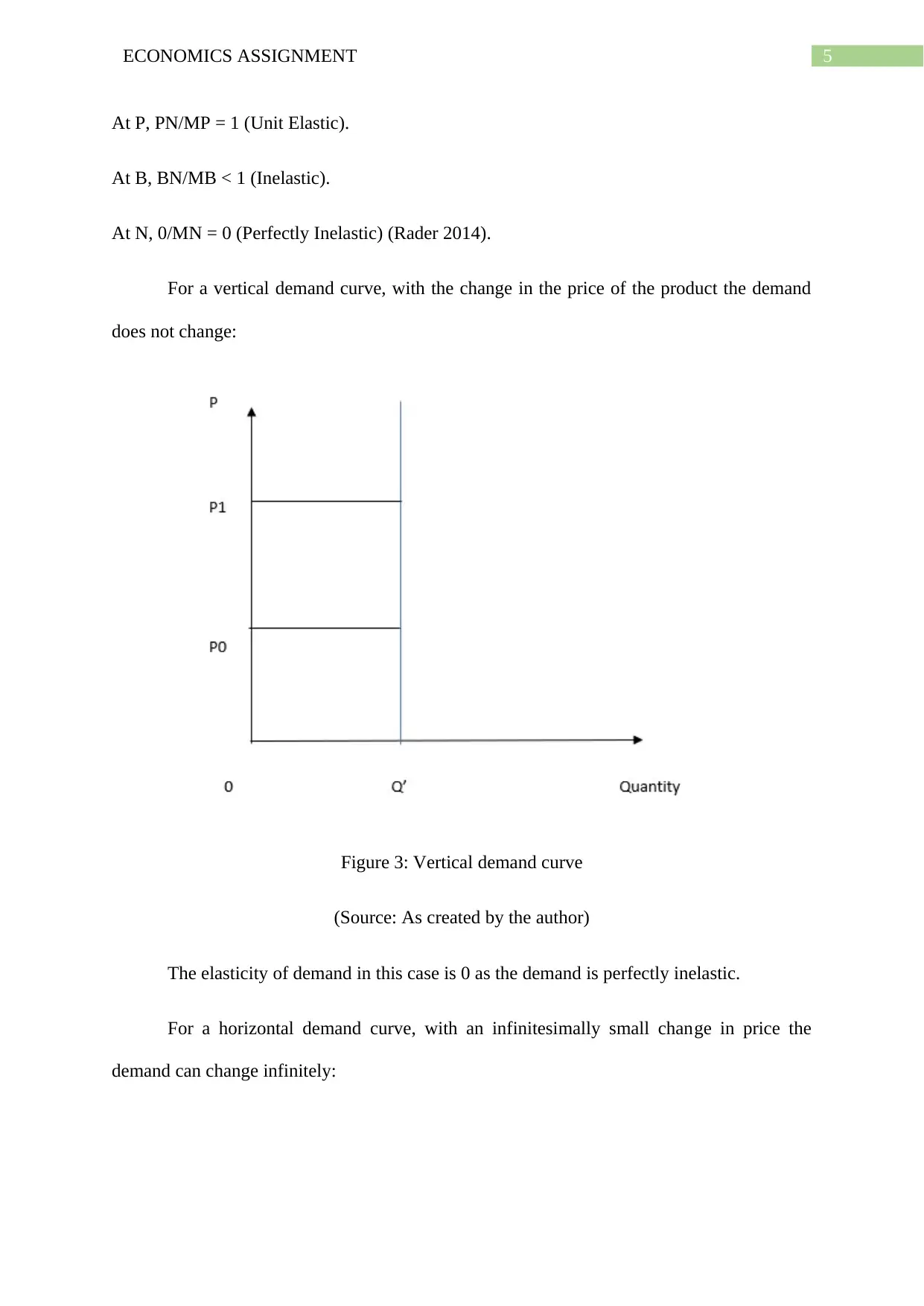
5ECONOMICS ASSIGNMENT
At P, PN/MP = 1 (Unit Elastic).
At B, BN/MB < 1 (Inelastic).
At N, 0/MN = 0 (Perfectly Inelastic) (Rader 2014).
For a vertical demand curve, with the change in the price of the product the demand
does not change:
Figure 3: Vertical demand curve
(Source: As created by the author)
The elasticity of demand in this case is 0 as the demand is perfectly inelastic.
For a horizontal demand curve, with an infinitesimally small change in price the
demand can change infinitely:
At P, PN/MP = 1 (Unit Elastic).
At B, BN/MB < 1 (Inelastic).
At N, 0/MN = 0 (Perfectly Inelastic) (Rader 2014).
For a vertical demand curve, with the change in the price of the product the demand
does not change:
Figure 3: Vertical demand curve
(Source: As created by the author)
The elasticity of demand in this case is 0 as the demand is perfectly inelastic.
For a horizontal demand curve, with an infinitesimally small change in price the
demand can change infinitely:
⊘ This is a preview!⊘
Do you want full access?
Subscribe today to unlock all pages.

Trusted by 1+ million students worldwide
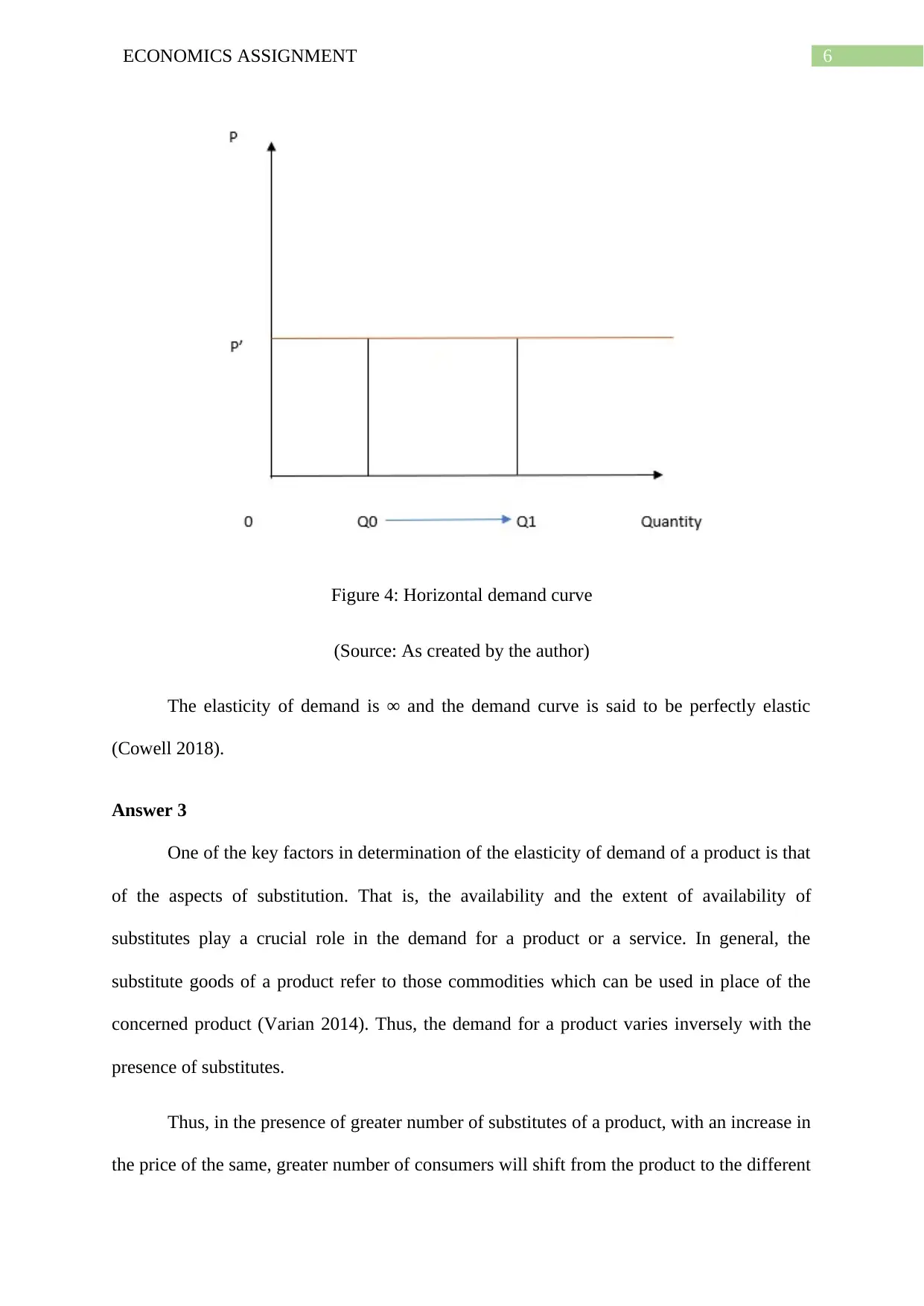
6ECONOMICS ASSIGNMENT
Figure 4: Horizontal demand curve
(Source: As created by the author)
The elasticity of demand is ∞ and the demand curve is said to be perfectly elastic
(Cowell 2018).
Answer 3
One of the key factors in determination of the elasticity of demand of a product is that
of the aspects of substitution. That is, the availability and the extent of availability of
substitutes play a crucial role in the demand for a product or a service. In general, the
substitute goods of a product refer to those commodities which can be used in place of the
concerned product (Varian 2014). Thus, the demand for a product varies inversely with the
presence of substitutes.
Thus, in the presence of greater number of substitutes of a product, with an increase in
the price of the same, greater number of consumers will shift from the product to the different
Figure 4: Horizontal demand curve
(Source: As created by the author)
The elasticity of demand is ∞ and the demand curve is said to be perfectly elastic
(Cowell 2018).
Answer 3
One of the key factors in determination of the elasticity of demand of a product is that
of the aspects of substitution. That is, the availability and the extent of availability of
substitutes play a crucial role in the demand for a product or a service. In general, the
substitute goods of a product refer to those commodities which can be used in place of the
concerned product (Varian 2014). Thus, the demand for a product varies inversely with the
presence of substitutes.
Thus, in the presence of greater number of substitutes of a product, with an increase in
the price of the same, greater number of consumers will shift from the product to the different
Paraphrase This Document
Need a fresh take? Get an instant paraphrase of this document with our AI Paraphraser
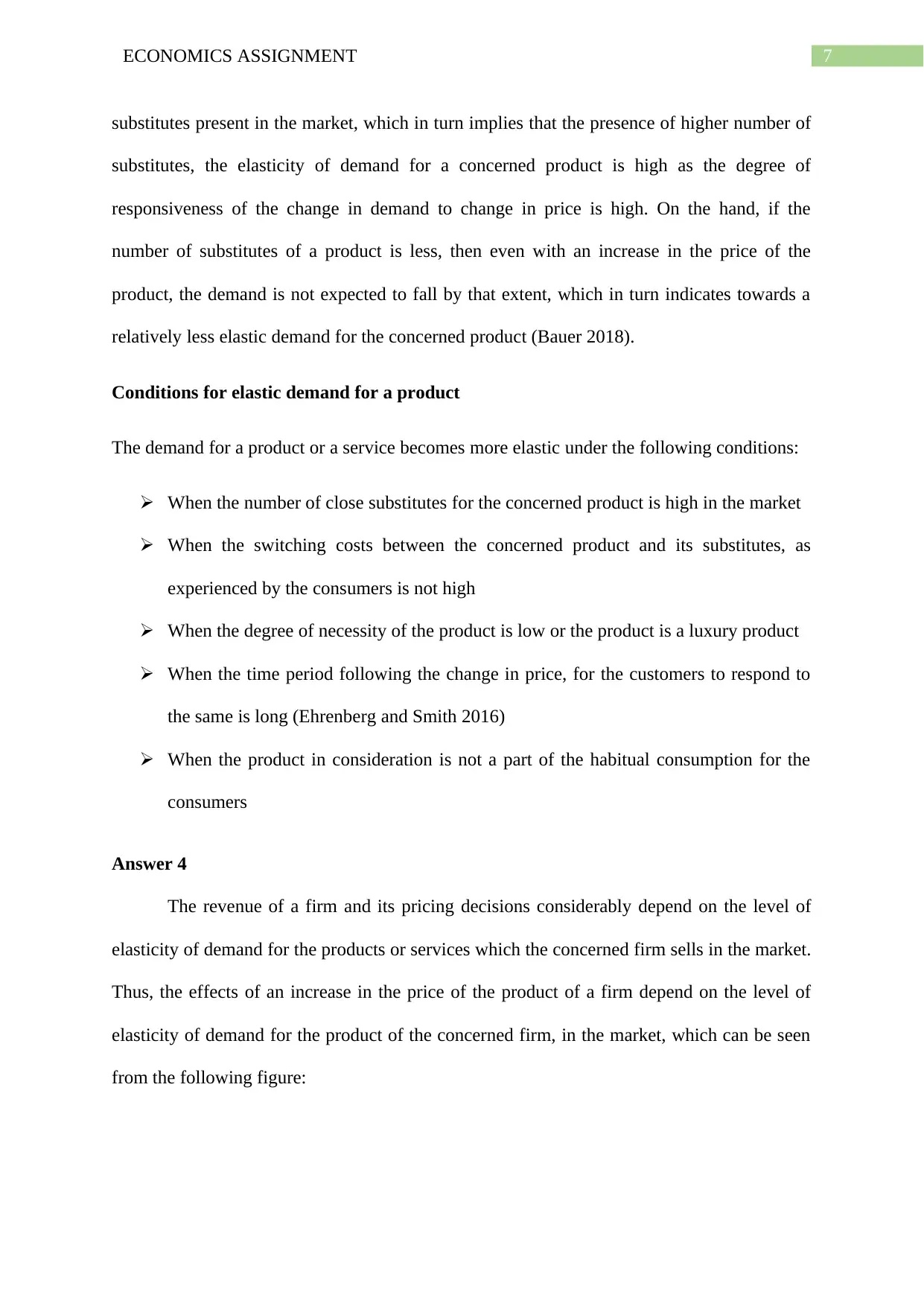
7ECONOMICS ASSIGNMENT
substitutes present in the market, which in turn implies that the presence of higher number of
substitutes, the elasticity of demand for a concerned product is high as the degree of
responsiveness of the change in demand to change in price is high. On the hand, if the
number of substitutes of a product is less, then even with an increase in the price of the
product, the demand is not expected to fall by that extent, which in turn indicates towards a
relatively less elastic demand for the concerned product (Bauer 2018).
Conditions for elastic demand for a product
The demand for a product or a service becomes more elastic under the following conditions:
When the number of close substitutes for the concerned product is high in the market
When the switching costs between the concerned product and its substitutes, as
experienced by the consumers is not high
When the degree of necessity of the product is low or the product is a luxury product
When the time period following the change in price, for the customers to respond to
the same is long (Ehrenberg and Smith 2016)
When the product in consideration is not a part of the habitual consumption for the
consumers
Answer 4
The revenue of a firm and its pricing decisions considerably depend on the level of
elasticity of demand for the products or services which the concerned firm sells in the market.
Thus, the effects of an increase in the price of the product of a firm depend on the level of
elasticity of demand for the product of the concerned firm, in the market, which can be seen
from the following figure:
substitutes present in the market, which in turn implies that the presence of higher number of
substitutes, the elasticity of demand for a concerned product is high as the degree of
responsiveness of the change in demand to change in price is high. On the hand, if the
number of substitutes of a product is less, then even with an increase in the price of the
product, the demand is not expected to fall by that extent, which in turn indicates towards a
relatively less elastic demand for the concerned product (Bauer 2018).
Conditions for elastic demand for a product
The demand for a product or a service becomes more elastic under the following conditions:
When the number of close substitutes for the concerned product is high in the market
When the switching costs between the concerned product and its substitutes, as
experienced by the consumers is not high
When the degree of necessity of the product is low or the product is a luxury product
When the time period following the change in price, for the customers to respond to
the same is long (Ehrenberg and Smith 2016)
When the product in consideration is not a part of the habitual consumption for the
consumers
Answer 4
The revenue of a firm and its pricing decisions considerably depend on the level of
elasticity of demand for the products or services which the concerned firm sells in the market.
Thus, the effects of an increase in the price of the product of a firm depend on the level of
elasticity of demand for the product of the concerned firm, in the market, which can be seen
from the following figure:
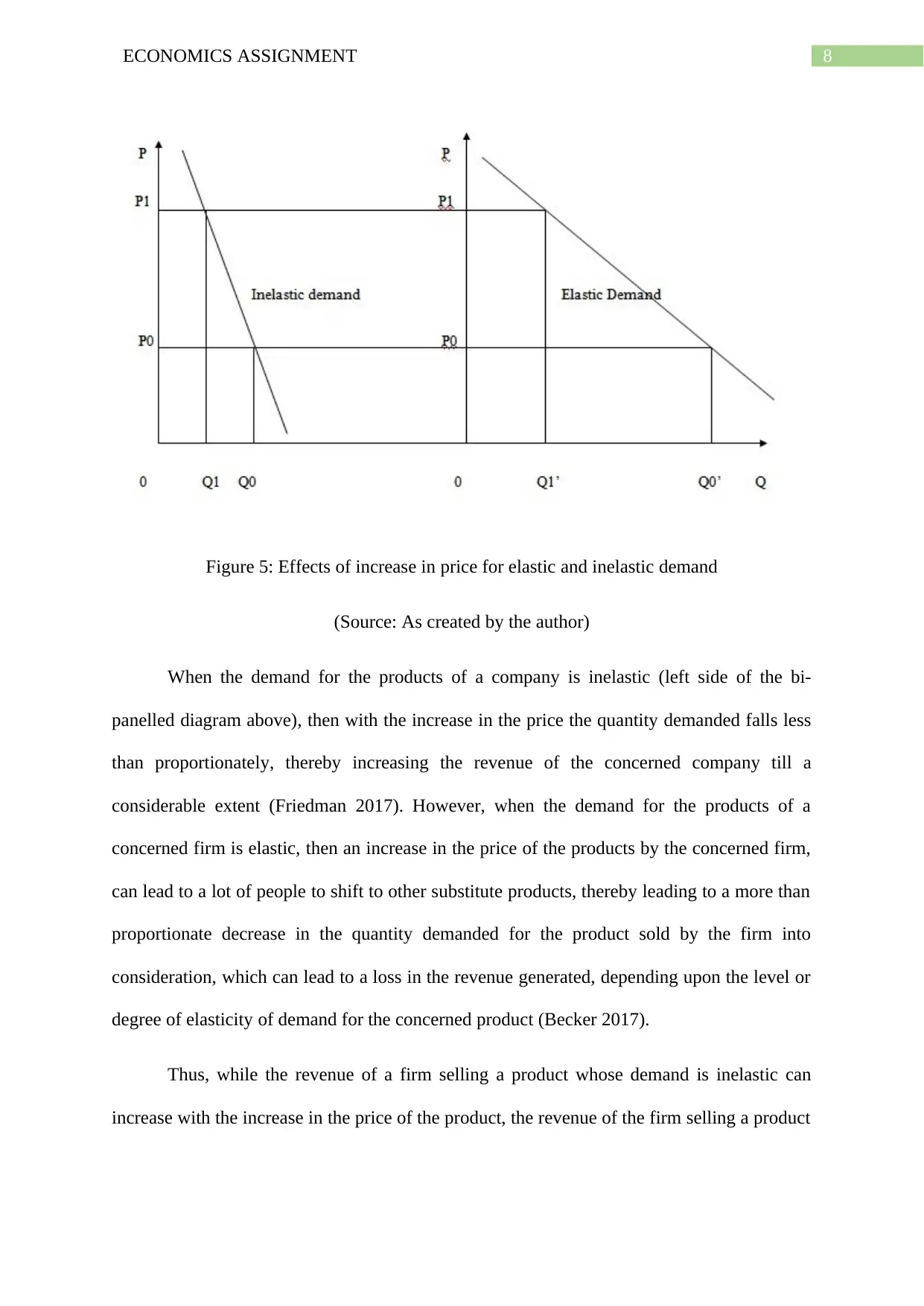
8ECONOMICS ASSIGNMENT
Figure 5: Effects of increase in price for elastic and inelastic demand
(Source: As created by the author)
When the demand for the products of a company is inelastic (left side of the bi-
panelled diagram above), then with the increase in the price the quantity demanded falls less
than proportionately, thereby increasing the revenue of the concerned company till a
considerable extent (Friedman 2017). However, when the demand for the products of a
concerned firm is elastic, then an increase in the price of the products by the concerned firm,
can lead to a lot of people to shift to other substitute products, thereby leading to a more than
proportionate decrease in the quantity demanded for the product sold by the firm into
consideration, which can lead to a loss in the revenue generated, depending upon the level or
degree of elasticity of demand for the concerned product (Becker 2017).
Thus, while the revenue of a firm selling a product whose demand is inelastic can
increase with the increase in the price of the product, the revenue of the firm selling a product
Figure 5: Effects of increase in price for elastic and inelastic demand
(Source: As created by the author)
When the demand for the products of a company is inelastic (left side of the bi-
panelled diagram above), then with the increase in the price the quantity demanded falls less
than proportionately, thereby increasing the revenue of the concerned company till a
considerable extent (Friedman 2017). However, when the demand for the products of a
concerned firm is elastic, then an increase in the price of the products by the concerned firm,
can lead to a lot of people to shift to other substitute products, thereby leading to a more than
proportionate decrease in the quantity demanded for the product sold by the firm into
consideration, which can lead to a loss in the revenue generated, depending upon the level or
degree of elasticity of demand for the concerned product (Becker 2017).
Thus, while the revenue of a firm selling a product whose demand is inelastic can
increase with the increase in the price of the product, the revenue of the firm selling a product
⊘ This is a preview!⊘
Do you want full access?
Subscribe today to unlock all pages.

Trusted by 1+ million students worldwide
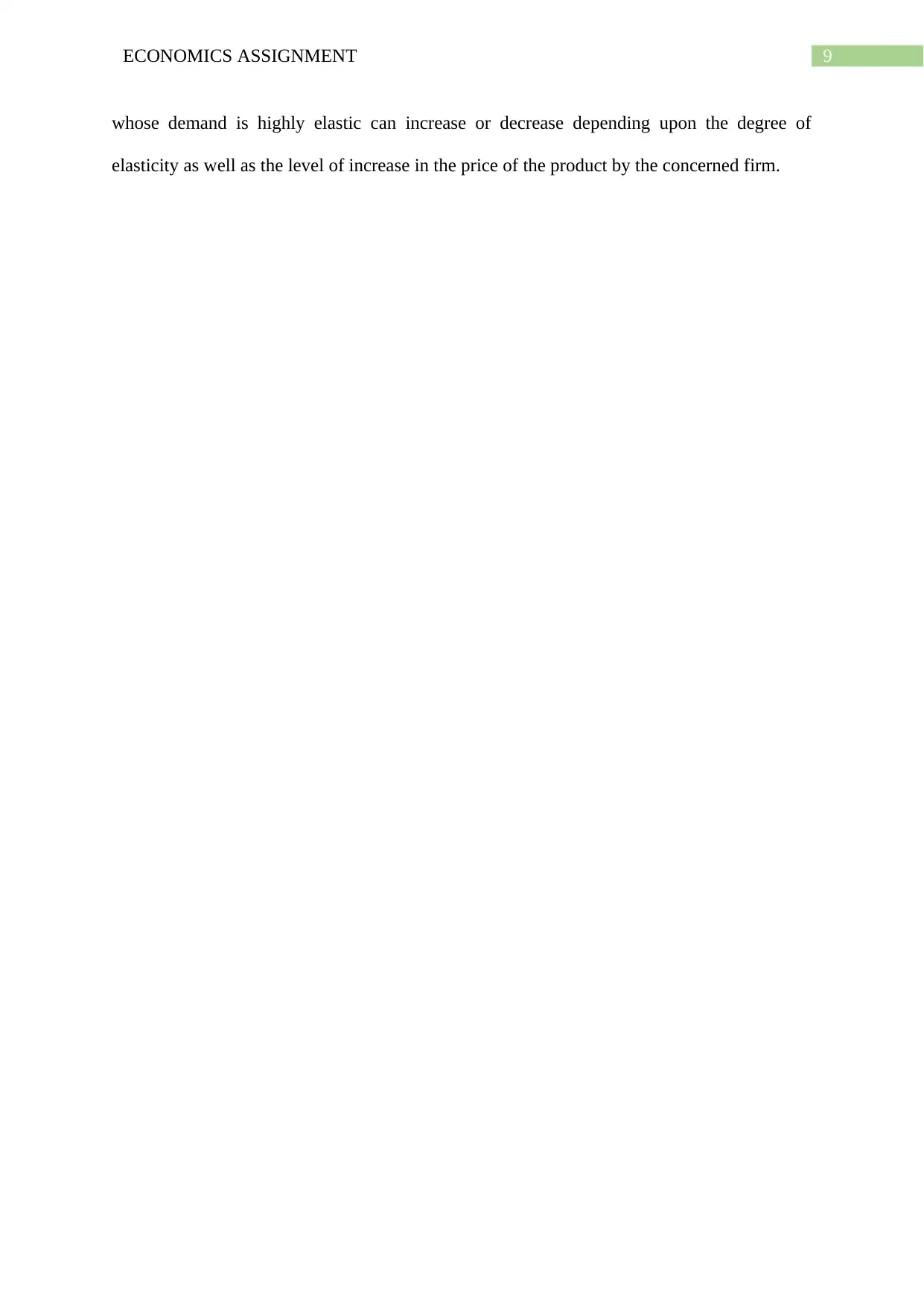
9ECONOMICS ASSIGNMENT
whose demand is highly elastic can increase or decrease depending upon the degree of
elasticity as well as the level of increase in the price of the product by the concerned firm.
whose demand is highly elastic can increase or decrease depending upon the degree of
elasticity as well as the level of increase in the price of the product by the concerned firm.
Paraphrase This Document
Need a fresh take? Get an instant paraphrase of this document with our AI Paraphraser
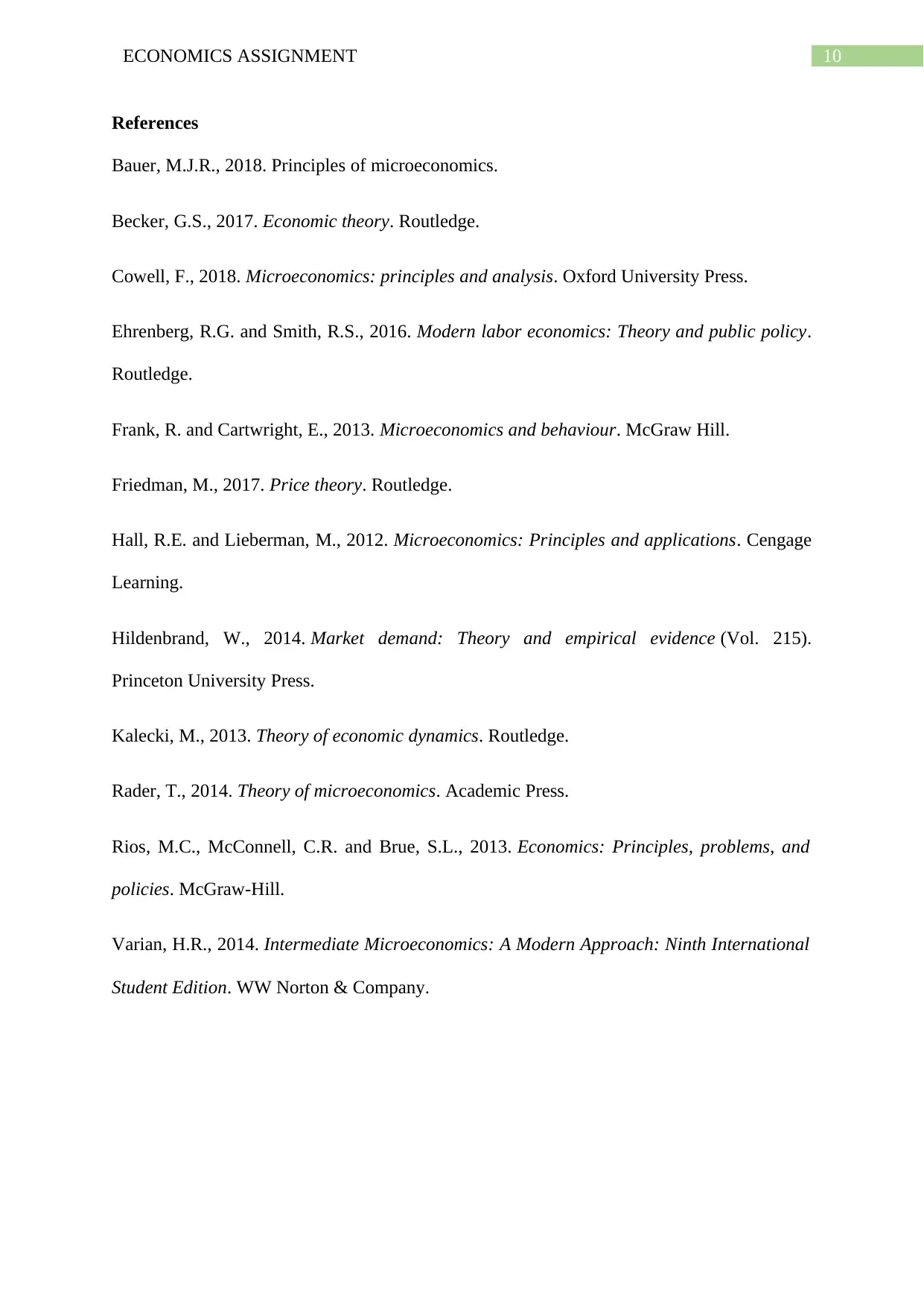
10ECONOMICS ASSIGNMENT
References
Bauer, M.J.R., 2018. Principles of microeconomics.
Becker, G.S., 2017. Economic theory. Routledge.
Cowell, F., 2018. Microeconomics: principles and analysis. Oxford University Press.
Ehrenberg, R.G. and Smith, R.S., 2016. Modern labor economics: Theory and public policy.
Routledge.
Frank, R. and Cartwright, E., 2013. Microeconomics and behaviour. McGraw Hill.
Friedman, M., 2017. Price theory. Routledge.
Hall, R.E. and Lieberman, M., 2012. Microeconomics: Principles and applications. Cengage
Learning.
Hildenbrand, W., 2014. Market demand: Theory and empirical evidence (Vol. 215).
Princeton University Press.
Kalecki, M., 2013. Theory of economic dynamics. Routledge.
Rader, T., 2014. Theory of microeconomics. Academic Press.
Rios, M.C., McConnell, C.R. and Brue, S.L., 2013. Economics: Principles, problems, and
policies. McGraw-Hill.
Varian, H.R., 2014. Intermediate Microeconomics: A Modern Approach: Ninth International
Student Edition. WW Norton & Company.
References
Bauer, M.J.R., 2018. Principles of microeconomics.
Becker, G.S., 2017. Economic theory. Routledge.
Cowell, F., 2018. Microeconomics: principles and analysis. Oxford University Press.
Ehrenberg, R.G. and Smith, R.S., 2016. Modern labor economics: Theory and public policy.
Routledge.
Frank, R. and Cartwright, E., 2013. Microeconomics and behaviour. McGraw Hill.
Friedman, M., 2017. Price theory. Routledge.
Hall, R.E. and Lieberman, M., 2012. Microeconomics: Principles and applications. Cengage
Learning.
Hildenbrand, W., 2014. Market demand: Theory and empirical evidence (Vol. 215).
Princeton University Press.
Kalecki, M., 2013. Theory of economic dynamics. Routledge.
Rader, T., 2014. Theory of microeconomics. Academic Press.
Rios, M.C., McConnell, C.R. and Brue, S.L., 2013. Economics: Principles, problems, and
policies. McGraw-Hill.
Varian, H.R., 2014. Intermediate Microeconomics: A Modern Approach: Ninth International
Student Edition. WW Norton & Company.
1 out of 11
Related Documents
Your All-in-One AI-Powered Toolkit for Academic Success.
+13062052269
info@desklib.com
Available 24*7 on WhatsApp / Email
![[object Object]](/_next/static/media/star-bottom.7253800d.svg)
Unlock your academic potential
Copyright © 2020–2025 A2Z Services. All Rights Reserved. Developed and managed by ZUCOL.




